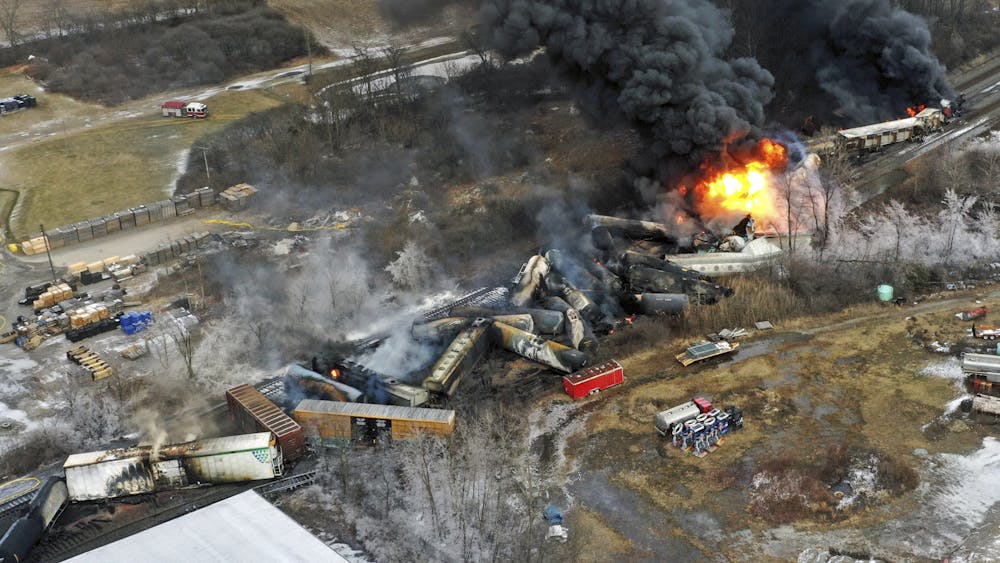Investigation Into Toxic Chemical Contamination Following Ohio Train Derailment

Table of Contents
The Extent of Chemical Contamination
The derailment caused a significant chemical spill, releasing a cocktail of toxic substances into the surrounding environment. The precise extent of the contamination remains under investigation, but initial reports and ongoing testing reveal widespread pollution affecting soil, water, and air. The primary chemicals of concern include:
- Vinyl chloride: A known carcinogen linked to liver cancer, brain tumors, and other serious health problems.
- Butyl acrylate: An irritant that can cause respiratory issues, skin irritation, and eye damage.
- Ethylene glycol monobutyl ether: A solvent with potential reproductive and developmental toxicity.
Environmental testing is underway to determine the precise levels of contamination. This includes:
- Water contamination levels: Testing of nearby rivers and streams like the Ohio River and Leslie Run is ongoing to assess the extent of water pollution and potential impact on drinking water supplies. Initial findings indicate elevated levels of contaminants in some areas.
- Soil contamination analysis: Soil samples are being collected and analyzed near the derailment site to determine the extent of soil contamination and the potential for long-term environmental damage.
- Air quality monitoring results: Air quality monitoring continues to assess the presence of toxic chemicals in the air and the potential for respiratory problems among residents.
- Long-term effects of ground water contamination: The potential for long-term contamination of groundwater sources is a significant concern, requiring extensive monitoring and remediation efforts.
Health Impacts on Residents and Wildlife
Reports from East Palestine residents indicate a range of health issues potentially linked to exposure to the released chemicals. These include:
- Reported health symptoms: Residents have reported experiencing respiratory problems (coughing, shortness of breath), headaches, nausea, skin irritation, and other symptoms.
- Impact on local livestock and wildlife populations: The impact on local wildlife, including fish, birds, and other animals, is also a serious concern. Studies are needed to assess the long-term ecological consequences.
- Long-term health studies needed: Long-term health studies are crucial to fully assess the impact on both human and animal populations and determine the potential for long-term health consequences, including birth defects and other chronic illnesses.
- Potential for birth defects and other long-term health issues: Exposure to these chemicals during pregnancy can have devastating consequences for the developing fetus, and long-term exposure may increase the risk of various cancers and other chronic conditions.
The Cleanup and Remediation Efforts
Norfolk Southern, the railway company responsible for the train, is leading the cleanup efforts under the supervision of government agencies like the EPA. The strategies include:
- Methods used for soil and water decontamination: Cleanup efforts involve excavating contaminated soil, implementing water treatment systems, and potentially using other advanced remediation techniques to remove or neutralize the hazardous substances.
- Norfolk Southern's role and responsibility: Norfolk Southern has committed to funding the cleanup and remediation efforts. However, the extent of their responsibility and liability remain subject to ongoing investigation and potential legal action.
- Government oversight and regulatory responses: Government agencies are providing oversight and ensuring the effectiveness of the cleanup process and compliance with environmental regulations.
- Challenges in the long-term cleanup and monitoring process: The long-term monitoring of the site is crucial to ensure the effectiveness of remediation efforts and prevent future contamination. This process is expected to span several years.
Legal and Regulatory Implications
The Ohio train derailment has significant legal and regulatory implications. This includes:
- Ongoing EPA investigations and findings: The EPA is conducting a thorough investigation to determine the full extent of the contamination and hold responsible parties accountable.
- Potential lawsuits against Norfolk Southern: Numerous lawsuits are expected against Norfolk Southern, claiming damages related to property damage, health impacts, and environmental harm.
- Review of existing environmental regulations: The derailment highlights potential weaknesses in existing environmental regulations, specifically concerning the transportation and handling of hazardous materials.
- Calls for stricter safety regulations in the rail industry: There are widespread calls for stricter safety regulations and improved oversight of the railway industry to prevent similar incidents in the future.
Conclusion
The Ohio train derailment and the resulting toxic chemical contamination represent a significant environmental and public health crisis. The extent of contamination, the potential long-term health effects, and the challenges involved in cleanup and remediation are substantial. Thorough investigation, accountability for responsible parties, and significant regulatory reforms are crucial to prevent similar incidents. Stay informed about ongoing investigations, participate in public forums, and advocate for stricter regulations concerning the transportation of hazardous materials to ensure the safety of our communities and the environment. Continued awareness and engagement regarding the Ohio train derailment and the prevention of future toxic chemical contamination are paramount.

Featured Posts
-
 Exploring Dr Terrors House Of Horrors A Visitors Guide
May 26, 2025
Exploring Dr Terrors House Of Horrors A Visitors Guide
May 26, 2025 -
 Adios A Eddie Jordan Ultima Hora Sobre Su Fallecimiento
May 26, 2025
Adios A Eddie Jordan Ultima Hora Sobre Su Fallecimiento
May 26, 2025 -
 The End Of Ryujinx Nintendos Influence On Emulator Development
May 26, 2025
The End Of Ryujinx Nintendos Influence On Emulator Development
May 26, 2025 -
 Enfants Ecartes En Age Le Temoignage De Melanie Thierry Et Raphael
May 26, 2025
Enfants Ecartes En Age Le Temoignage De Melanie Thierry Et Raphael
May 26, 2025 -
 Gold Price Surge Trumps Eu Threats Fuel Trade War Fears
May 26, 2025
Gold Price Surge Trumps Eu Threats Fuel Trade War Fears
May 26, 2025
Latest Posts
-
 Nba Mathurins 28 Points Power Pacers Past Nets In Overtime
May 28, 2025
Nba Mathurins 28 Points Power Pacers Past Nets In Overtime
May 28, 2025 -
 Indiana Pacers Defeat Brooklyn Nets Mathurins Stellar Game
May 28, 2025
Indiana Pacers Defeat Brooklyn Nets Mathurins Stellar Game
May 28, 2025 -
 Pacers Beat Nets In Overtime Mathurins 28 Point Performance
May 28, 2025
Pacers Beat Nets In Overtime Mathurins 28 Point Performance
May 28, 2025 -
 Indiana Pacers Injury News Mathurins Status Questionable
May 28, 2025
Indiana Pacers Injury News Mathurins Status Questionable
May 28, 2025 -
 Bennedict Mathurin Injury Update Pacers Vs Kings
May 28, 2025
Bennedict Mathurin Injury Update Pacers Vs Kings
May 28, 2025
